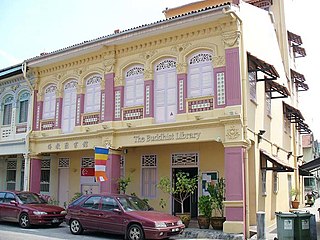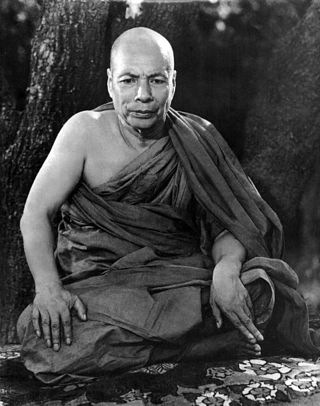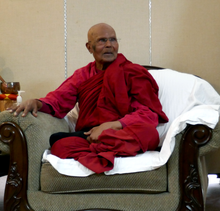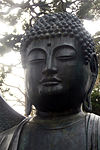
The Noble Eightfold Path or Eight Right Paths is an early summary of the path of Buddhist practices leading to liberation from samsara, the painful cycle of rebirth, in the form of nirvana.
Theravāda is the most commonly accepted name of Buddhism's oldest existing school. The school's adherents, termed Theravādins, have preserved their version of Gautama Buddha's teaching or Buddha Dhamma in the Pāli Canon for over two millennia.

Buddhaghosa was a 5th-century Indian Theravada Buddhist commentator, translator and philosopher. He worked in the Great Monastery (Mahāvihāra) at Anurādhapura, Sri Lanka and saw himself as being part of the Vibhajjavāda school and in the lineage of the Sinhalese Mahāvihāra.
Satipatthana is a central practice in the Buddha's teachings, meaning "the establishment of mindfulness" or "presence of mindfulness", or alternatively "foundations of mindfulness", aiding the development of a wholesome state of mind. In Theravada Buddhism, applying mindful attention to four domains, the body, feelings, the mind, and key principles or categories of the Buddha's teaching (dhammās), is thought to aid the elimination of the five hindrances and the development of the seven aspects of wakefulness.

Phra VisuddhisamvaratheraAM, known as Ajahn Brahmavaṃso, or simply Ajahn Brahm, is a British-born Theravada Buddhist monk. Currently, Ajahn Brahm is the abbot of Bodhinyana Monastery in Serpentine, Western Australia; Spiritual Adviser to the Buddhist Society of Victoria; Spiritual Adviser to the Buddhist Society of South Australia; Spiritual Patron of the Buddhist Fellowship in Singapore; Patron of the Brahm Centre in Singapore; Spiritual Adviser to the Anukampa Bhikkhuni Project in the UK; and Spiritual Director of the Buddhist Society of Western Australia (BSWA). He returned to the office on 22 April 2018 after briefly resigning in March, following a contentious vote by members of the BSWA during their annual general meeting.

The term American Buddhism can be used to describe all Buddhist groups within the United States, including Asian-American Buddhists born into the faith, who comprise the largest percentage of Buddhists in the country.
In Buddhism, kammaṭṭhāna is a Pali word which literally means place of work. Its original meaning was someone's occupation but this meaning has developed into several distinct but related usages all having to do with Buddhist meditation.

The Visuddhimagga, is the 'great treatise' on Buddhist practice and Theravāda Abhidhamma written by Buddhaghosa approximately in the 5th century in Sri Lanka. It is a manual condensing and systematizing the 5th century understanding and interpretation of the Buddhist path as maintained by the elders of the Mahavihara Monastery in Anuradhapura, Sri Lanka.
The Vipassanā movement, also called the Insight Meditation Movement and American Vipassana movement, refers to a branch of modern Burmese Theravāda Buddhism that promotes "bare insight" (sukha-Vipassana) to attain stream entry and preserve the Buddhist teachings, which gained widespread popularity since the 1950s, and to its western derivatives which have been popularised since the 1970s, giving rise to the more dhyana-oriented mindfulness movement.
Sati, literally "memory" or "retention", commonly translated as mindfulness, "to remember to observe," is an essential part of Buddhist practice. It has the related meanings of calling to mind the wholesome dhammas such as the four establishments of mindfulness, the five faculties, the five powers, the seven awakening-factors, the Noble Eightfold Path, and the attainment of insight, and the actual practice of maintaining a lucid awareness of the dhammas of bodily and mental phenomena, in order to counter the arising of unwholesome states, and to develop wholesome states. It is the first factor of the Seven Factors of Enlightenment. "Correct" or "right" mindfulness is the seventh element of the Noble Eightfold Path.

Bhante, sometimes also Bhadanta, is a respectful title used to address Buddhist monks, nuns, and superiors, especially in the Theravada tradition. In English, the term is often translated as Venerable.
The Satipaṭṭhāna Sutta, and the subsequently created Mahāsatipaṭṭhāna Sutta, are two of the most celebrated and widely studied discourses in the Pāli Canon of Theravada Buddhism, acting as the foundation for contemporary vipassana meditation practice. The Pāli texts of the Satipaṭṭhāna Sutta and the Mahāsatipaṭṭhāna Sutta are largely similar in content; the main difference being a section about the Four Noble Truths in the Observation of Phenomena (Dhammānupassana), which is greatly expanded in the Mahāsatipaṭṭhāna Sutta. These suttas (discourses) stress the practice of sati (mindfulness) "for the purification of beings, for the overcoming of sorrow and lamentation, for the extinguishing of suffering and grief, for walking on the path of truth, for the realization of nibbāna."
The Mettā Sutta is the name used for two Buddhist discourses found in the Pali Canon. The one, more often chanted by Theravadin monks, is also referred to as Karaṇīyamettā Sutta after the opening word, Karaṇīyam, "(This is what) should be done." It is found in the Suttanipāta and Khuddakapāṭha. It is ten verses in length and it extols both the virtuous qualities and the meditative development of mettā (Pali), traditionally translated as "loving kindness" or "friendliness". Additionally, Thanissaro Bhikkhu's translation, "goodwill", underscores that the practice is used to develop wishes for unconditional goodwill towards the object of the wish.
Matthew Flickstein is a teacher of insight (vipassana) meditation. He was formerly a psychotherapist, and at one time was ordained as a Buddhist monk in the Theravada tradition. Flickstein’s primary teacher has been the Venerable Bhante Henepola Gunaratana.

Ayya Sudhamma Bhikkhuni is abbess of Charlotte Buddhist Vihara. The first American woman ordained in Sri Lanka, Ayya Sudhamma has been recognized at the United Nations in Bangkok as an "Outstanding Woman in Buddhism."

The Buddhist Library is the first dedicated Buddhist library in Singapore. The library, which is located in a shophouse in Geylang, aims to meet the needs of the Buddhist community and anyone interested in Buddhism. It is unique in that it is not a voluntary association or a temple and because it takes a non-sectarian approach to Buddhism. Besides functioning as a lending library, it also organises Dhamma talks, accredited Buddhist courses, public art exhibitions and welfare work locally and abroad.

Hammalawa Saddhatissa Maha Thera (1914–1990) was an ordained Buddhist monk, missionary and author from Sri Lanka, educated in Varanasi, London, and Edinburgh. He was a contemporary of Walpola Rahula, also of Sri Lanka.

U Vimala, commonly known as the Mogok Sayadaw, was a renowned bhikkhu and vipassanā meditation master of Theravada Buddhism.

In the oldest texts of Buddhism, dhyāna or jhāna is a component of the training of the mind (bhavana), commonly translated as meditation, to withdraw the mind from the automatic responses to sense-impressions, "burn up" the defilements, and leading to a "state of perfect equanimity and awareness (upekkhā-sati-parisuddhi)." Dhyāna may have been the core practice of pre-sectarian Buddhism, in combination with several related practices which together lead to perfected mindfulness and detachment.
Samatha, "calm," "serenity," "tranquility of awareness," and vipassanā, literally "special, super, seeing ", are two qualities of the mind developed in tandem in Buddhist practice.












